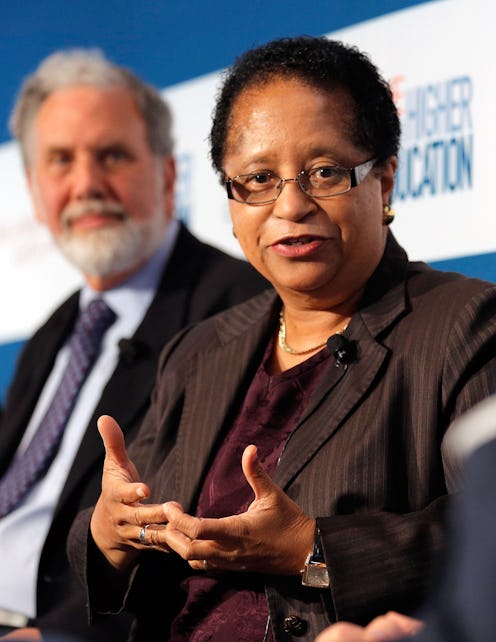News
9 Female Scientists You Should Know
We've long heard about the gender gap in science, but according to recent studies, that gap might be slowly but surely closing. More women are getting Ph.Ds in science, tech, engineering, and mathematics. Men and women are experiencing similar rates of success with grant and article submission. In fact, in tenure track hiring, female candidates are now often preferred over male ones, according to The Proceedings of the National Academy of Sciences. So what better way to remind ourselves that women are just as capable as men than with a list of concrete examples of just that? In the spirit of progress, here are some badass female scientists you should've learned about in school, but probably didn't.
You've heard of Madame Curie. You've watched those adorable ape videos with Jane Goodall. But the truth of the matter is that there aren't that many celebrated female scientists throughout history. It's no wonder that girls grow up with the mindset that they just are not cut out for science. But the truth is that there have been many women who made critical, world-altering discoveries in a variety of fields — some surpassing their male peers. Below we have just a tiny fraction of the most important female figures in the history of science.
1. Rita Levi-Montalcini
Italian neurologist Rita Levi-Montalcini won the Nobel Prize in 1986 for her discovery of Nerve Growth Factor (NFG), which she began analyzing in 1952. Nerve growth factor is a protein that regulates cell growth, the first of its kind to be described. Levi-Montalcini's discoveries were revolutionary in embryology. They led to the understanding of several conditions, such as senile dementia, developmental malformations and tumors. During World War II, she couldn't legally pursue science under Mussolini’s regime, which banned non-Aryans from professional careers, so Levi-Montalcini created her own lab in her home. Talk about dedication!
2. Barbara McClintock
McClintock was a pioneer in the study of the genetics of corn. At Cold Spring Harbor, New York, she observed the patterns of coloration of corn kernels over generations, leading to the determination that genes could move within and between chromosomes. This finding was totally against the conventional understanding of genetics at the time, so of course it was largely ignored. It wasn't until the late 1970s that molecular technology was able to confirm her theory of “jumping genes” in humans and microorganisms alike. She won the Nobel Prize in 1983.
3. Shirley Ann Jackson
An award-winning physicist, Jackson was the first African-American woman to attain a doctorate degree at MIT in the discipline. Her work examined subatomic particles and explored theories on the interactions of elementary particles. In 1974, she went to Switzerland’s European Center for Nuclear Research (CERN) to explore various theories about the strong interaction of elementary particles. Her prolific work and analysis of neutrons, electrons and other particles has advanced the field of physics.
4. Caroline Herschel
Having mastered singing, Herschel switched to science — specifically, astronomy. She discovered a bit more than a handful of new nebulae throughout the late 1700s. Her catalog of nebulae, in fact, increased the number of known star clusters from 100 to 2,500. She was also the first British woman to be financially compensated for her scientific work.
5. Rosalind Franklin
Rosalind Franklin discovered the double helical structure of DNA, which she demonstrated in an X-ray experiment. As an X-ray crystallographer and biophysicist, she contributed to the comprehension of the structures of molecules, as well as viruses. She died at age 37 of ovarian cancer.
6. Maria Mitchell
Another astronomer, Maria Mitchell was exceptionally precocious. At 17, she had already established her own school for girls, focusing on science and math. In 1847, she discovered a comet through her telescope, earning a gold medal from the king of Denmark (Caroline Herschel had won this same award a few year earlier). The comet was named "Miss Mitchell's Comet." Mitchell was the first female astronomy professor in the United States, hired by Vassar College in 1865.
7. Lise Meitner
After receiving her doctorate from the University of Vienna in 1906, Lise Meitner began to collaborate with Otto Hahn on the study of radioactive elements. As an Austrian Jewish woman, she wasn't allowed in the main labs, and could work only in the basement. Even after she was forced to flee Nazi Germany in 1938, she and Hahn continued to work together. After Hahn discovered that uranium atoms would split when bombarded with neutrons, it was Meitner who calculated and named the phenomenon of “nuclear fission.” This led to the development of the atomic bomb, but only Hahn was awarded the Nobel Prize in 1944.
8. Melissa Franklin
Melissa Franklin is the physics department chair at Harvard. As an experimental particle physicist, she was in charge of the Fermi National Acceleration Lab team which discovered the first signs of the existence of the top quark. Franklin was the first woman to get tenure at the Harvard Physics department, and in 1993, she was elected a fellow of the American Society of Physics.
9. Chien-Shiung Wu
Dubbed the Chinese Marie Curie, Chien-Shiung Wu was a physicist and expert in radioactivity. As a contributor in the Manhattan Project early in World War II, she helped develop the process for obtaining uranium ore to produce the fuel for the atomic bomb. Her research at Columbia University helped to disprove the law of conservation of parity — previously considered a fundamental law of nature. She was awarded the National Medal of Science in1975 and the John Price Wetherill Medal at the Franklin Institute in 1962.
So there you have it. Nine badass ladies who were trailblazers in the field of science when women had to really fight for their place in the laboratory. As of late 2014, female scientists still account for only 30 percent of scientists worldwide. Things might be better, but we've still got a long way to go.
Images: Wikipedia Commons (4); PopTech/Flickr; IAEA Imagebank/Flickr
